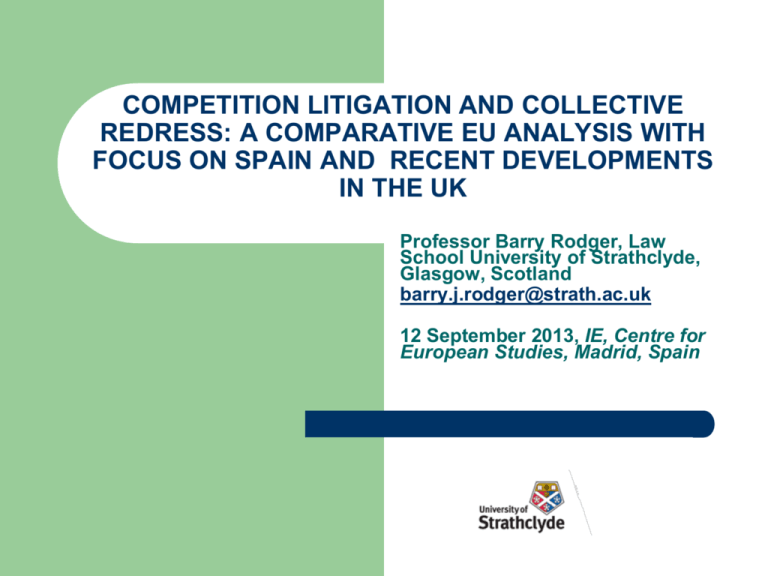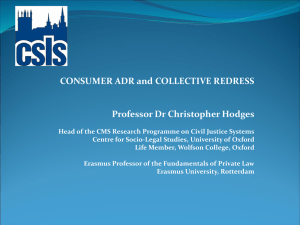Competition Law litigation in the UK Courts: A study of all cases to
advertisement

COMPETITION LITIGATION AND COLLECTIVE REDRESS: A COMPARATIVE EU ANALYSIS WITH FOCUS ON SPAIN AND RECENT DEVELOPMENTS IN THE UK Professor Barry Rodger, Law School University of Strathclyde, Glasgow, Scotland barry.j.rodger@strath.ac.uk 12 September 2013, IE, Centre for European Studies, Madrid, Spain Times Higher Education Awards PART 1-The AHRC Project- COMPARATIVE PRIVATE ENFORCEMENT AND COLLECTIVE REDRESS IN THE EU Private EnforcementIntroduction 1 US comparison- mature system of private antitrust litigation:- discovery/funding/class actions/treble damages EU and UK- traditional public/admin enforcement- (Commission/OFT) Note direct effect doctrine and UK reformCompetition Act 1998 Private EnforcementIntroduction 2 Developments in last 20 years:Competition Act 1998/Enterprise Act 2002 ECJ rulings- Crehan and Manfredi Leniency and Regulation 1/2003 See Commission White Paper of 2008 EU- focus on collective redress- See Commission Recommendation 2013 UK Context, CAT and BIS proposed reforms (2013)- Consumer Rights Bill cl82, Sch7 Private EnforcementIntroduction 3 Ashurst Report- 2004- 60 damages actions White Paper, External Study- further 96 See Rodger 2006 ECLR re all UK cases to 2004/Rodger 2009 GCLR >2008 Hidden story of settlement activity (2008 ECLR)- marked difference from US See also work of Sebastian Peyer (Germany) Empirical work in competition law Work on compliance in 2000 and 2005- and study of compliance following OFT infringement action2007/2008 Quantitative private enforcement research re UK litigation and Article 234 project Looking at settlements:- ‘Private Enforcement of Competition Law, The Hidden Story..’ [2008] ECLR 96 ‘Why not court?: A study of Follow-on Actions in the UK?’ Journal of Antitrust Enforcement (2013)1-28 Recent Collaborative projects Rationale/proposed outcomes of the research project 1 To provide quantitative data regarding litigation involving EU and/or domestic competition law within the relevant time framework within each Member State, and thereby identify trends in terms of frequency of competition law cases To provide insights into the context of competition law private enforcement within each Member State, to include:- eg the availability/form of follow-on actions/specialist courts etc. Rationale/proposed outcomes of the research project 2 To consider the extent to which consumer enforcement of competition law is available, by considering the legislative context and the case-law involving consumers,, with a view to assessing the effectiveness of the regime for consumer redress, To contribute to academic and policy debates about the future place and role for private enforcement of competition law in the UK and across the European Union. AHRC Project Submission of Funding application Funding approval (long review process) Role of national rapporteurs- 27 States Workshop in Glasgow, March 12, to finalise agreed methodology Conference, London, Sep 12, to present draft reports and related presentations See www.clcpecreu.co.uk Institutional Background Legislative background Specialist Court/Tribunal? Discovery/Costs and Funding issues Remedies Collective Redress Mechanisms Reform Difficulties of a comparative approach… INSTITUTIONAL ISSUES 1 National Courts’ hierarchies- (methodology) Specialist Courts/Tribunals Certain Member States- Including the UK (CAT), see also Austria (Cartel Court); Denmark (Maritime and Commercial Court) Follow on/Stand alone actions INSTITUTIONAL ISSUES 2 Collective Redress focus Mechanisms,Opt-in/Opt-Out Spectrum-see Mulheron Various approaches across Member States- eg UK opt-in(and reform); Austria (collective action Austria style); Denmark – opt-in/out; Finnish class actions; German aggregation; Ireland group actions; Italy azione di classe (2009); Lithuania- theoretical?; Malta Collective Proceedings Act 12; Netherlands Portugal and France each have well-recognised (little used) systems.etc developing area national/EU Limited Case-Law- see below Case-Law :Methodology Role of National Rapporteurs Timescale (1 May 1999-1 May 2012) Particular national difficulties- locating case-law general problems/difficulties in understanding/consistency of approach The scope of ‘competition law-related rulings’- judgments only (not settlements) Private not public enforcement Any stage of litigation process Not only damages actions- other remedies/shield Not ADR- eg mediation Empirical data Number of cases/Years Follow-on and stand alone Success rates Stage of litigation Provisions relied upon Remedies Collective/consumer redress case-law DISCUSSION OF EMPIRICAL CASE LAW SPSS to analyse data Note special position of Germany/Bulgaria Note analysis of individual countries/combined data for each issue Also crosstabs eg year v follow-on action Combined data (1268 cases included)Year/Provisions/Remedy/Success/Consumer New MS/Limited/Developing/Considerable Experience (NOTE SPAIN!) SPAIN CASES PROVISIONS RELIED UPON PROVISIONS RELIED UPON Frequency Percent Cumulative Percent Art.101 121 37.5 37.5 Art. 102 14 4.3 41.8 Domestic Art. 101 41 12.7 54.5 Domestic Art. 102 41 12.7 67.2 57 17.6 84.8 23 7.1 92.0 26 8.0 100.0 323 100.0 Art. 101 and Domestic Art. 102 and Domestic Combination Total PROJECT OVERVIEW 1 Work in progress!! See Competition Law: Comparative Private Enforcement and Collective Redress in the EU, (Kluwer Law International, 2013) Mixed landscape (Germany> Bulgaria). More cases than anticipated- Spain in particular Why?-the difficult question! S van de Valle, Private Antitrust Litigation in the EU and Japan (2012) re Japan- Ch 1- Plan/market-rational economy and bureaucratic/legalistic culture (State/corporatist responses to market failure) National stories/contexts-Affected by national cultures, competition architecture and civil procedure (eg remedies, follow-on, courts) PROJECT OVERVIEW 2 Germany?- specific costs issue (no disincentive) and general/nebulous competition/litigation culture and knowledge/experience of lawyers Most common- stand alone business contractual disputes- Germany, Netherlands and Spain (vertical/distribution agreements) Widespread use as defence/injunctions (increase re damages 10/11 (UK) and more successful…)? consumer cases rare (<4%)-exemplified by Spain Chicken and egg- rules and mechanisms or apathy PART 2- Competition Law Private Enforcement in the UK: Case-Law, Recent Developments and Proposals for Reform The Changing Landscape of UK Competition law- Post 1998- I Competition Act 1998 - Chapter I and II prohibitions modelled on 81/82 (now Arts 101 and 102 TFEU) Investigative and fining powers Role for OFT and CAT (and regulators) CAT a specialist tribunal to hear appeals, judicial review and monetary claims Enterprise Act 2002- Personal sanctions- Cartel offence and Director Disqualification The Changing Landscape of UK Competition law- Post 1998- II Enterprise and Regulatory Reform Act Key Change, OFT and CC combine to form Competition and Markets Authority (‘CMA’) Royal Assent 25th April 2013 UK Legislative Framework- Private Enforcement Competition Act 1998- s58, though no express provision Enterprise Act 2002 Section 47A- follow on actions before the CAT (High Court still available) s47B- consumer representative action Which? (The Consumers’ Association) v JJB Sports FOLLOW ON ACTIONS IN THE UK ‘The Public Private Enforcement Relationship: Followon Actions in the UK’ In Il Private Enforcement del Diritto Comunitario della concorrenza: Ruolo e Competenze dei Guidici nazionali, pp157-180 CEDAM, 2009, G A Benacchio and M Carpagnano eds.(and ‘Competition Law Litigation in the UK Courts: a study of all cases 2005-2008’ [2009] 2 GCLR 93-114; 136-147) Ten Years of UK Competition Law Reform, DUP, 2010UK Competition Law and Private Litigation ‘Why not court?: A study of Follow-on Actions in the UK?’ Journal of Antitrust Enforcement (2013)1-28 Follow On Actions 1 Limited number of claims to date (but leave footprint and increasing)-disappointing, partially explained by systemic reasons below Mostly following Commission decisions, judgments mostly procedural skirmishes s47B? Representative actions- Which v JJBsettled Follow On Actions 2 High Court- why? eg non monetary claims- EWS Devenish post Vitamins claim(High Ct/CA) re unjust enrichment- limitation period rationale Another rationale- suspensive requirements for CAT action National Grid – High Court action raised during appeal process- jurisdiction reasons Follow On Actions 3 Limitation rules before the CAT- dependent on the post-infringement appeal process 2 years from relevant date Considerable case-law BCL Old Co Ltd v BASF I-> CA held that application to annul fine did not extend period, time-barred Cf Deutsche Bahn re claim v non-appealing addressee Follow On Actions 4 Success? Enron v EWS (follow on to ORR decision), Overcharge claim-difficulty in relying on a complex infringement decision- CA First Trial- lost opportunity- unsuccessful But note Healthcare at Home Ltd v Genzyme and interim payment of £2m And see 2 Travel Group success (?) incl award of exemplary damages and £1.6m award in Albion Water (28/3/13) Stand-alone Actions Change in recent years- shield>sword Abuse cases- eg refusal to supply/EF doctrine/predatory pricing See eg Purple Parking (2011) Limited abuse decisional practice by OFT Note also exploitative- excessive pricing but difficulties eg CA in AttheRaces Ltd v BHRB TABLE 4.7- UK CASES REMEDIES SOUGHT REMEDY SOUGHT Frequency Percent Cumulative Percent Damages 45 42.5 42.5 Injunction 15 14.2 56.6 Defence 27 25.5 82.1 Declaration 5 4.7 86.8 Pre-action disclosure 2 1.9 88.7 12 11.3 100.0 106 100.0 Damages and other Remedy Total UK- Review Slow, steady increasing practice (106 judgments in 80 disputes in period) Limited success and impact of ‘success’- few final judgments but interim process /settlements Limited follow-on, recent increase but mainly procedural rulings on limitation etc Representative action system criticised How best to facilitate and encourage private enforcement in the UK? Immature system compared to US- need development of procedural/substantive rules but signs of progress eg 2 Travel Group/Albion Water Key themes Funding/costs- CFA’s, ATE and Arkin third party funding- contingency fees? LASPO Act 12- damages-based agreements Damages- multiple? Compensation focus per Devenish. Generally unresolved issues. But see 2 Travel Group/ Albion Water Collective Redress-. Note the limitations on s47B- Which v JJB Proposals for Reform EU Level Commission White Paper Stalled Draft Directive> Collective Redress Consultation process and EU measure? Non-binding recommendation on Collective Redress/ Directive on Antitrust Damages UK Level OFT proposals for reform on Collective redress optin/opt-out mechanism English procedural limitations demonstrated by Emerald Supplies v British Airways REFORM Dept of Business Innovation and Skills (BIS) January 2013 : Private Actions in Competition Law: A Consultation on options for reform- government response at https://www.gov.uk/government/uploads/syst em/uploads/attachment_data/file/70185/13501-private-actions-in-competition-law-aconsultation-on-options-for-reformgovernment-response1.pdf Follows consultation doc, April 24, 2012 BIS PROPOSALS Enhance the role of the CAT as a venue for competition actions in the UK Introduce opt-out collective actions regime Promote ADR Ensure private actions complement the public enforcement regime ROLE OF CAT Extend role to stand-alone actions- and harmonise limitation periods with normal civil courts Power to grant injunctions Fast-track for simpler cases The CAT as a plaything of business only? Collective Actions Regime Limited opt-out regime with safeguards Certification basis (real complexities re commonality – pass through problems!) Either consumers or businesses or a combination of the 2 Judicial approval of opt-out settlement and new opt-out collective settlement regime Consumer Rights Bill cl 82 and Schedule 7 Conclusions Final damages judgment- 2 Travel Group and subsequently Albion Water Significant developments- statute and CAT Relatively limited case-law- Settlements Funding and cost rules disincentives but indications that increasing resort to court- High Court 2 Travel and Albion Water damages breakthroughexceptional Fairly radical BIS proposals, CAT as a European hub and for consumer redress- Consumer Rights Bill CAT>Tiger? THE END/ El fin Thank you for listening Muchas gracias





